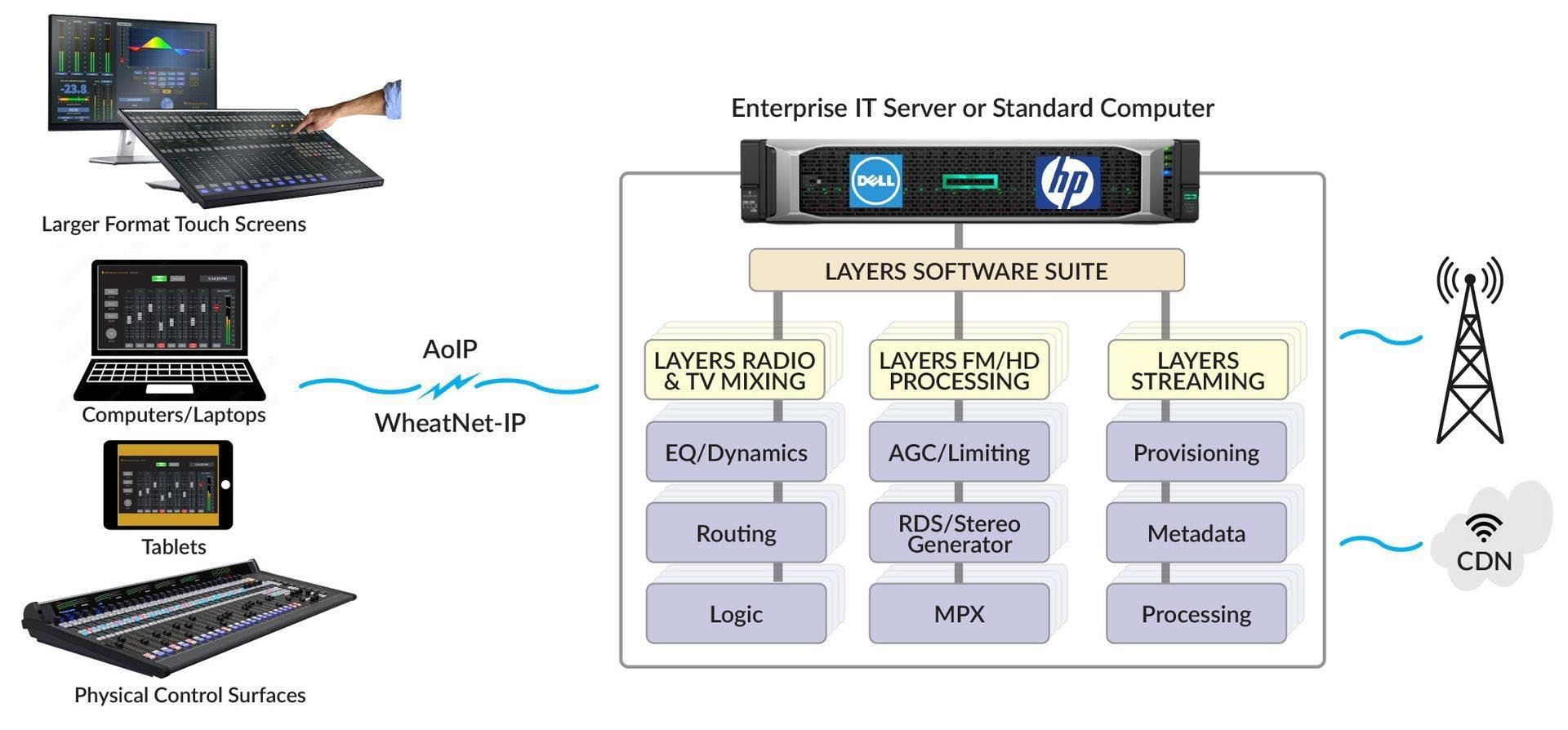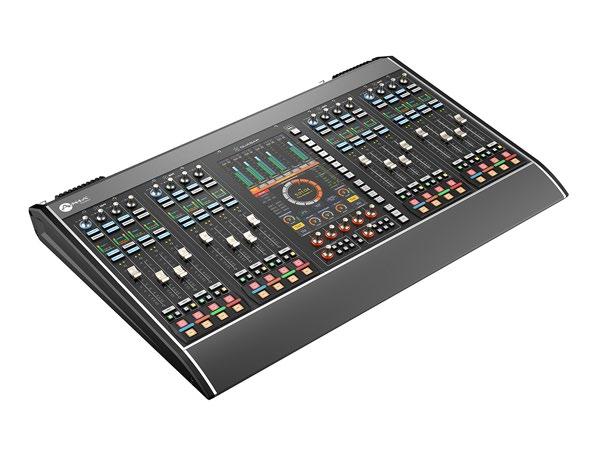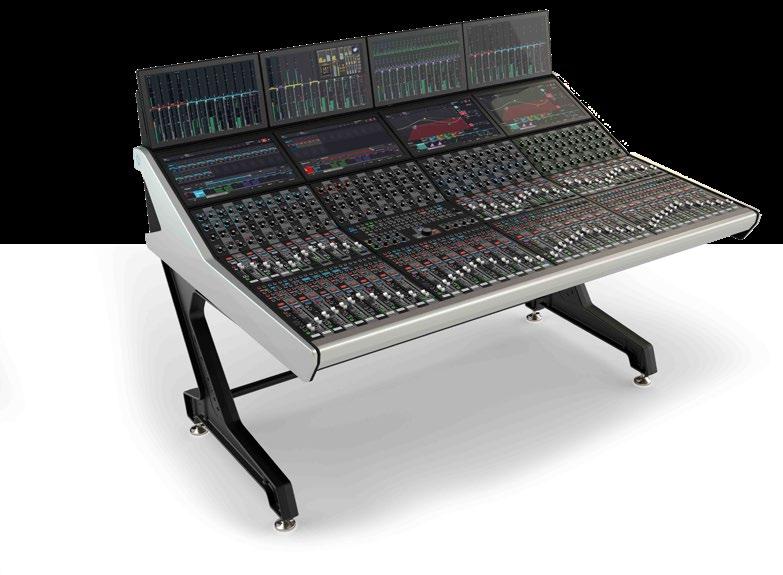
4 minute read
Audio in 2023: Virtual Mixing, Cloud and AoIP
NAB Show exhibitors focus on how IP is revolutionizing audio production
By Kevin Hilton
With the importance of sound now more appreciated in broadcasting, the audio technology sector is producing new products that meet changing operational and creative needs. Here’s a look at what some of the leading mixing console manufacturers will be showing at the 2023 NAB Show and how they see the market developing.
Audio may be represented by fewer companies at this year’s NAB Show compared to those in the video and visuals sector—as is ever the case—but it makes up for it with a concentration of new technologies that are having a major impact on broadcasting. Virtualization, immersive experiences, IP connectivity and the cloud are all current considerations for broadcasters and, in many respects, sound is leading the way.
Going Virtual
Virtual operations and the cloud in particular have been playing a role in audio installations over the last two decades. This trend began with the separation of the mixing control surface from the processing engine, with the latter located in a rack room within the broadcast center rather than with the mixer in the studio or control room. That partitioning has increased with the mix processors now more likely to be located in a third party remote facility connected via the cloud.
Among the audio exhibitors actively pushing this is Wheatstone, which will show its Layers Software Suite, which features a mix engine that can be placed either in an on-prem server or offsite at a cloud data center. The user interface, Layers Mix Glass, is designed to run on a standard laptop, tablet or PC touch screen, as well as a software app.
Phil Owens, senior sales engineer at Wheatstone, says they’re seeing increasing interest in virtual mixers and, particularly, in the ability to operate a production from a laptop or mobile device.

“This is the next big frontier,” he says, “and with that comes extending streaming, processing and, to some extent, mixing from a data center, either a local private one or a public cloud service such as AWS. Being able to spin up or down streaming as you need it has great value to broadcasters.”
The Layers system is part of the WheatNetIP audio networking system that Wheatstone will also be showing, along with the Tekton compact control surface and the Strata TV audio console. Owens says that although working remotely and in the cloud is being adopted, many broadcasters still prefer to mix on-premises because live sound mixing is latency sensitive.
“But those tradeoffs with latency and buffering for packet loss across distances is something we’re very familiar with as an AoIP [Audio over IP] manufacturer,” he says, “and today, we can make some pretty decent tradeoffs. This is not only because of the technology we use, like SRT for UDP transport, but also because of the growing number of data centers cropping up in cities.”
Ip Throughout The Chain
Telos Alliance, which helped pioneer AES67/ AoIP with its Livewire protocol, will showcase its latest Axia AoIP products, the Quasar XR and SR broadcast consoles. According to Telos Alliance Product Manager Larry Schindel, the SMPTE ST 2110 and AES67 interoperability standards are now being used increasingly as the AoIP components of TV sound, which itself is undergoing a change in how it is delivered.
“What we are seeing in the U.S. is broadcasters trying to take the signal all the way through the distribution chains,” he explains. “The more challenging part is not sending the final mix but having different outputs. Broadcasters can deliver a complete mix if they want.
“Today, if they are covering sports, the A1 mixer is creating a mix, with a clean feed, an international output and a bed mix,” Schindel adds. “Another will be a complete mix with the announcers. It’s not a big change but is an easy lift to get there [due to the technology].”
Ai In The Mix
Calrec Argo mixing system
Lawo will release v10.6 software for its A_UHD Core-based audio infrastructure at the show. This was first used during the 2022 World Cup and features immersive audio tools that can be used to create NGA (next generation audio) material, with support for various channels formats, including 5.1.4, 7.1.4, 9.1.6 and 4.0.4.
Lawo says it will also unveil two new hardware products during the show but had no further details at press time.
Lawo says it is also seeing more pressure being put on audio engineers and mixers to produce and manage multiple mixes and outputs. This, according to Christian Struck, senior product manager for audio production for Lawo, will call for the greater use of automation and cognitive technologies to cope with the increase in signal volume.
“As the workload for sound supervisors increases, one has to be sure that what is sent out can be consumed in the intended way,” he says. “It will become increasingly important to tackle automated mixing and AI as supportive measures for audio engineers. The mixing console as we know it and tablets, or other control protocol-based user interfaces, clearly need to adapt to new production models.”
Adapting To New Requirements
Audio console manufacturers have long offered different options to meet a wide range of user requirements and are now taking that further using modular techniques and IP.


Calrec Audio has taken this route with the Argo mixing system, which will make its NAB Show debut alongside the new ImPulse1 IP engine (launched in January). Argo comes in two models: the larger Q, with two mid-level rows of interchangeable panels, and the smaller S, which has only one midlevel row.
ImPulse1 is a small version of the established ImPulse IP core and is intended to be more cost-effective and compact while still being a 128 input channel DSP device in a 1U package.
Henry Goodman, head of sales and marketing for Calrec, explains that the ImPulse1 is aimed at broadcasters that do not necessarily need a multi-console environment. He adds that audio mixing requirements will continue to change, although manufacturers, including Calrec, are already making accommodations for newer technologies such as immersive audio and object-based monitoring and metering.
“At the moment it’s a question of how the operational side of a production is done and how that changes the way people use the console,” Goodman said. “It’s still in its infancy but it’s feasible for an operator working on a live show to effectively do multiple mixes for different presentations at the same time.”
The 2023 NAB Show promises to be a good showcase for broadcast sound technology and may very well provide some pointers as to where the future of audio mixing is heading. l










